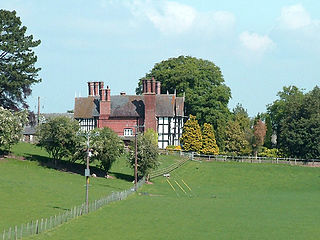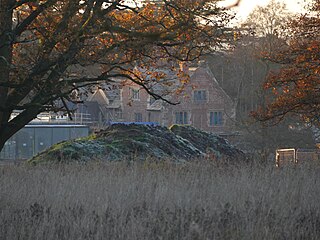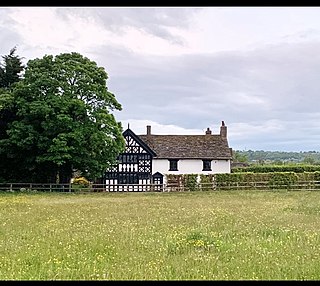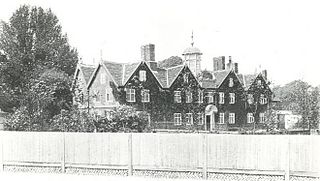Related Research Articles

Broxton Old Hall is in Old Coach Road 0.5 miles (1 km) west of the village of Brown Knowl, in the civil parish of Broxton, Cheshire, England. It is recorded in the National Heritage List for England as a designated Grade II listed building.

Moss Hall, Audlem, is a manor house 0.5 miles (1 km) north-west of Audlem, Cheshire, England. It is recorded in the National Heritage List for England as a designated Grade I-listed building. The Hall overlooks the Shropshire Union Canal.
The Grade I listed buildings in Cheshire, excluding those in the city of Chester, total around 80. Almost half of these are churches that are contained in a separate list.

Poole Hall is a Regency mansion at Poole, near Nantwich in Cheshire, England. It dates from 1812 to 1817 and is recorded in the National Heritage List for England as a designated Grade II* listed building. Nikolaus Pevsner considered the interior to be "exceptionally fine". The hall is a private residence and is not open to the public.

Handforth Hall is a former manor house in Handforth, Cheshire, England. It is dated 1562, and was built for Sir Urian Brereton. Alterations have been made to it in the 17th century, and subsequently. The hall is a timber-framed building and currently consists of a single range, with two storeys and five bays. Originally it was either E-shaped or quadrilateral in plan. The hall is recorded in the National Heritage List for England as a designated Grade II* listed building. It was at one time the home of Sir William Brereton, a Parliamentary commander in the English Civil War.

Alderley Old Hall is the remaining part of a former 17th-century manor house near the village of Nether Alderley, Cheshire, England. It stands adjacent to the mill pond of Nether Alderley Mill, a loop of which acts as a moat. The hall is recorded in the National Heritage List for England as a designated Grade II* listed building.
Portal is a country house standing to the northeast of the village of Tarporley, Cheshire, England. It was built in 1900–05. The architect was Walter E. Tower, nephew and partner of the stained glass designer and manufacturer C. E. Kempe. It is a timber-framed building in Domestic Revival style. The house is recorded in the National Heritage List for England as a designated Grade II* listed building. The architectural historian Nikolaus Pevsner says of it: "It is a tour de force in accurate but scaled-up imitation of timber-framed mansions".

Birtles Hall is a country house in the parish of Over Alderley, Cheshire, England. It was built in about 1819 for the West Indies merchant Robert Hibbert.

Checkley Hall is a small country house in the parish of Checkley cum Wrinehill, Cheshire, England. The house was built in 1694 by the Delves family of Doddington, replacing an earlier timber-framed house. It was altered in the late 18th or early 19th century, replacing a hipped roof with an attic. The house is constructed in brick with a tiled roof. It has 2½ storeys, and an entrance front with five bays. The house is recorded in the National Heritage List for England as a designated Grade II* listed building. Its gate piers are listed at Grade II.
Crewood Hall is a country house to the northeast of the village of Kingsley, Cheshire, England. It dates from the 16th century, and has a porch dated 1638. Initially timber-framed, the building was encased in brick and remodelled in the 19th century. It has stone dressings and tiled roofs, and is in two storeys. The house consists of a hall with two cross wings and a two-storey porch at the end of the left wing. The lower storey of the porch is in sandstone and in the upper storey the timber-framing is exposed. The house is recorded in the National Heritage List for England as a designated Grade II* listed building. Associated with the house, and also listed at Grade II, are two farm buildings; stables, and a shippon and barn.

Davenham Hall is a former country house to the southeast of the village of Davenham, Cheshire, England. It was built for Thomas Ravenscroft to replace a timber-framed house called Davenham Lodge. It dates from the middle or the later part of the 18th century, possibly from shortly before 1795, when Ravenscroft died. Substantial additions were made in the early 19th century. It is constructed in stuccoed brick, and has a slate roof. The house is in two storeys with a symmetrical entrance front of six bays. Occupying the middle two bays is a porch with four Tuscan columns and an entablature containing a triglyph. Above this, the central bays protrude slightly forwards and contain two windows, with a pediment above them and a parapet on each side. Figueirdo and Treuherz describe the interior as being "especially fine". The entrance hall contains Grecian plasterwork and a black marble chimneypiece. The drawing room has more delicate plasterwork, and a marble chimneypiece decorated with dancing figures. The central staircase hall is lit by a central dome, and has fan-shaped plasterwork. The staircase has a wrought iron baluster, and the first floor landing has a screen of four Doric columns. The house was converted into a nursing home in 1980. It is recorded in the National Heritage List for England as a designated Grade II* listed building.

Duddon Old Hall is a country house in the village of Duddon, Cheshire, England. It dates from the later part of the 16th century, the house was in the ownership of the Done family at this time. Alterations and additions were made in the early 19th century, and later in the century the timber framing was restored in 1903–4 and these works may be associated to local architect John Douglas of Chester. The timber framing was most recently extensively repaired between September 2021 and April 2022. It is constructed partly in timber-framing, and partly in brick, on a stone plinth. It is roofed partly in stone-slate, and partly in Welsh slate. The plan consists of a hall with a cross wing. The house is in two storeys, and its south front has four bays. The bay at the left end is timber-framed; it projects and has a gable with a bargeboard. The architectural historian Nikolaus Pevsner comments that the black-and-white decoration of this bay is "very rich". It consists of studding in the ground floor, lozenges and shaped balusters in the upper floor, and lozenges and serpentine struts in the gable. In the adjacent bay is a wooden doorcase with a triangular pediment. All the windows are casements. Internally, the main chamber is in the cross wing, which is open to the roof. The house is recorded in the National Heritage List for England as a designated Grade II listed building. To the northeast of the house is a 16th-century barn, constructed in timber-framing with brick infill, which is also listed at Grade II.

Hankelow Hall is a former country house to the north of the village of Hankelow, Cheshire, England.

Hawthorn Hall is a former country house in Hall Road, Wilmslow, Cheshire, England. It originated in about 1610 as a timber-framed yeoman house for John Chavman of mnc. It was improved and encased in brick for John Leigh in 1698. Its use changed in the 19th century, and in 1835 it opened as a homeless shelter school. During the 1960s the house served as a private residence. The building has since been used as offices. It is constructed in plum-coloured brick, with a Kerridge stone-slate roof, a stone ridge, and three brick chimneys. Parts of the timber-framing can still be seen in the roof gables, and in an internal wall. The plan consists of a long rectangle. The house is in 2½ storeys, and has a near-symmetrical north front. There are four gables with bargeboards and mace finials. Each gable contains a pair of wooden mullioned and transomed windows. In the centre is a doorway, flanked by plain pilasters, and surmounted by a segmental hood framing a cartouche containing the date 1698. At the top of the hall, above the door, is a small balustrade, behind which is a half-glazed lantern with a cupola and a weathervane. The south front is similar to the north front, although the door is not central. This door is flanked by fluted pilasters, and surmounted by a plaque with a lion rampant. The east front has two gables. The architectural historian Nikolaus Pevsner comments that the house is "good to look at, though conservative for its date". The house, together with parts of the garden walls, is recorded in the National Heritage List for England as a designated Grade II* listed building.

Holford Hall is a country house west of the village of Plumley, Cheshire, England. It consists of a fragment of a much larger timber-framed house, built in 1601 for Mary Cholmondeley on a moated site. Part of the building was demolished in the 1880s. The house is timber-framed with rendered infill. It has a stone-slate roof. The entrance front has two bays with gables and Ionic pilasters. The architectural historian Nikolaus Pevsner describes this front as being "highly decorated". The house is recorded in the National Heritage List for England as a designated Grade II* listed building. The stone bridge leading to the house across the moat is listed at Grade II, and the moated site on which the house stands is a scheduled monument.

Lower Kinnerton Hall, also known as Bridge Farmhouse, stands adjacent to the England-Wales border to the west of the village of Lower Kinnerton, Cheshire, England. The house is dated 1685, and carries the initials TTET. Attached to it is a shippon (cattle-shed) dating from the 18th century. A wing was added to the rear in the 19th century. The house is constructed in brown brick with stone dressings, and has a slated roof. It is in two storeys and its entrance front has five bays. There are three large Dutch gables on the entrance front, and another on the north face, each with reverse-curved scrolls supporting pediments. The windows are casements. At the rear of the house is a semi-hexagonal bay window and a timber-framed porch. The shippon is also in two storeys, and constructed in brick with slate roofs. Also at the rear of the house is a cobbled courtyard. The architectural historian Nikolaus Pevsner describes the building as "quite an impressive house". The house and attached shippon are recorded in the National Heritage List for England as a designated Grade II listed building.

Ramsdell Hall is a country house in the parish of Odd Rode in Cheshire, England, overlooking the Macclesfield Canal. It was built in two phases during the 18th century, and is still in private ownership.
Goostrey is a civil parish in Cheshire East, England. It contains 19 buildings that are recorded in the National Heritage List for England as designated listed buildings. Of these, one is listed at Grade I, the highest grade, three are listed at Grade II*, the middle grade, and the others are at Grade II. Apart from the village of Goostrey, the parish is mainly rural. It contains the Jodrell Bank Observatory, with its Grade I listed Lovell Telescope and its control building. In the village, the listed buildings include the church and associated structures, the former schoolmaster's house, and a row of cottages. Outside the village they include country houses, farmhouses, and farm buildings, some of which date back to the 16th century and are timber-framed.
Haughton is a civil parish in Cheshire East, England. It contains ten buildings that are recorded in the National Heritage List for England as designated listed buildings, all of which are at Grade II. This grade is the lowest of the three gradings given to listed buildings and is applied to "buildings of national importance and special interest". Apart from the village of Haughton, the parish is entirely rural. The listed buildings consist of houses and farms, and structures associated with them, and a public house. Four of the buildings date from the 17th century, and contain timber framing.
Poole is a civil parish in Cheshire East, England. It contains eight buildings that are recorded in the National Heritage List for England as designated listed buildings. Of these, one is listed at Grade II*, the middle grade, and the others are at Grade II. The parish is rural, and the listed buildings consist of a country house with an associated barn, farmhouses and farm buildings, a cottage, a bridge, a pinfold, and a chapel.
References
- 1 2 3 4 de Figueiredo, Peter; Treuherz, Julian (1988), Cheshire Country Houses, Chichester: Phillimore, p. 237, ISBN 0-85033-655-4
- 1 2 Historic England. "Hampton Old Hall (1129932)". National Heritage List for England . Retrieved 5 August 2012.
- ↑ Pevsner, Nikolaus; Hubbard, Edward (2003) [1971], Cheshire, The Buildings of England, New Haven and London: Yale University Press, p. 275, ISBN 0-300-09588-0
- ↑ Historic England. "Barn to northwest of Hampton Old Hall (1105659)". National Heritage List for England. Retrieved 5 August 2012.
Coordinates: 53°02′14″N2°44′05″W / 53.03725°N 2.73468°W